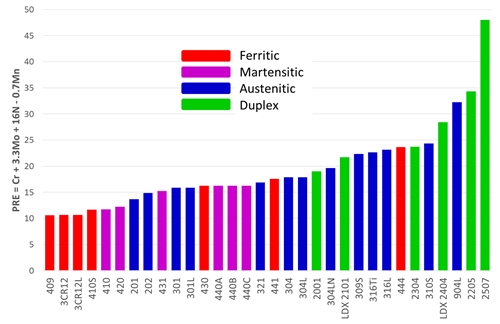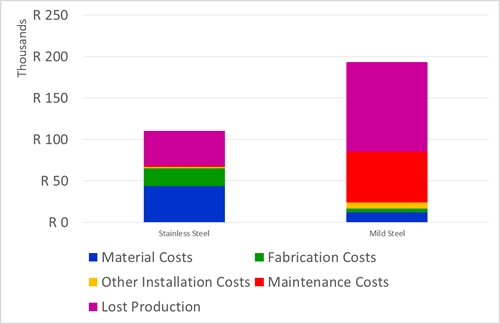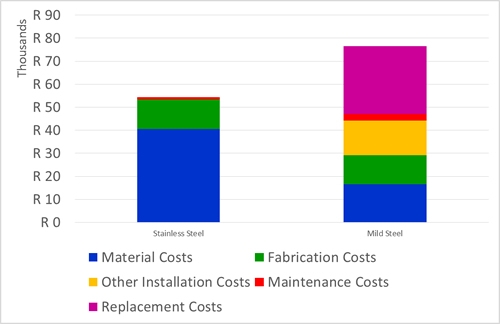- About Stainless
- 3CR12
- Care, Maintenance and Cleaning of Stainless Steel
- Colour Coding Chart
- Facts About Stainless
- Frequently Asked Questions
- World Stainless Association
- Introduction to Stainless Steel
- Life Cycle Costing and Stainless Steel
- LCC Software
- Maintaining Stainless Steel in and Around the House
- Stainless Steel In Architecture
- Preamble for Architects
- Standard A380/A30 M for cleaning and passivation of stainless steel
- Stainless Steel and the Environment
- Stainless Steel Roofing
- Surface Finishes
- Technical Advice & Support
- Technical Enquiries
- Types of Stainless
- Typical Applications
Stainless steels have traditionally been specified in applications where the primary requirement is for corrosion resistance. However, since their invention over 100 years ago, stainless steels have also been recognised for other attributes such as durability, versatility, quality, sustainability, hygiene and aesthetic appeal. It is this combination of properties that has seen stainless steels become the material of choice in a wide variety of uses, from the utensils and kitchenware used to prepare food, in a range of applications in the transport industry, as process equipment in the food and beverage industry, for the manufacture of pharmaceutical products, in the medical field, through to very demanding applications in the chemical processing and power generation industries.
What Makes Stainless Steels, Stainless?
Stainless steels contain at least 10.5% chromium and this forms a chromium rich passive layer on the surface of the steel. It is this passive layer that confers corrosion resistance on stainless steel. However, the key to stainless steel is that the passive layer is self-healing. Unlike coated carbon steel, which will rust or corrode if the coating is scratched or damaged, stainless steel has the ability to regenerate and heal the passive layer spontaneously. It is this corrosion resistance and the passive layer properties that makes stainless steel such an ideal choice in so many applications.
Which Alloying Elements Affect the Corrosion Resistance?
Higher alloyed stainless steel can resist very aggressive chloride, acidic or alkaline solutions, while the lower alloyed stainless steels can resist atmospheric corrosion. See Table 1 for the most common stainless steels used in South Africa. In general, increasing the chromium improves the general corrosion resistance, while increasing the chromium, nitrogen and molybdenum increases the pitting corrosion resistance. Pitting corrosion is a localised form of corrosion which can lead to small holes in the stainless steel. Halides, such as chlorides are the most common cause of pitting corrosion. The Pitting Resistance Equivalent is able to summarise the effect of chemical composition on the pitting resistance of a particular stainless steel grade. Figure 1 summarises the PRE of the most common stainless steel grades.

Figure 1: The Pitting Resistant Equivalent of Stainless Steels
Other elements, such as copper, tungsten, titanium and niobium can improve corrosion resistance to other specific corrosive environments.
Oxidation resistance at higher temperatures can be improved by increasing the chromium and silicon levels, while increasing the nickel content improves the spalling resistance of the oxide layer formed at these high temperatures. The heat resisting grades of stainless steels can resist oxidation up to temperatures as high as 1200°C.
Thus a knowledge of the application and the corrosive environment allows the selection of the most appropriate and cost effective grade.
What are the Properties of Stainless Steel?
There are three main groups of stainless steels that are classified according to their microstructure (or crystal arrangement of the atoms) as austenitic (comprising about 73% of all stainless steels), ferritic (about 20%), or duplex (about 1%) with the balance being martensitic, precipitation hardened or unknown. The chemical and mechanical property requirements of the most popular grades used in South Africa are shown in Tables 1 and 2.
Apart from the corrosion resistant properties, there are many other reasons to specify stainless steel. For example, the strength of stainless steel allows thinner sections to be used than with many other materials. Some grades of stainless steels, such as the duplex stainless steels, have strength levels double that of the austenitic or ferritic grades.
If ductility and formability are critical, such as in deep-drawing applications (e.g. pots, pans and sinks), then austenitic stainless steels have outstanding properties. Austenitic stainless steels also remain tough at very low temperatures, even down to that of liquid nitrogen, making them suitable for cryogenic applications. They retain this toughness after welding and are thus also suitable for applications such as process and pressure vessels. On the other hand, the martensitic stainless steels are extremely hard, but have lower toughness and ductility. They are ideal for knives and blades, etc. as they retain a sharp edge, as well as wear components, such as slat band chain conveyors. The ferritic stainless steels have an attractive combination of properties, in terms of strength and ductility, but they have poor toughness in thicker gauges (>2.5mm) and have poor toughness when welded. Their applications are thus limited to thin gauge applications, but they are substantially cheaper than austenitic stainless steels as they do not contain nickel. The exception to this low toughness is 3CR12 and 3CR12L. These utility ferritic stainless steels are tough, even when welded, and can be used in gauges up to 30mm.
What Finishes are Available?
Stainless steels are often selected for their visual appeal. They are available in industrial finishes, where aesthetics are not important, but they are also used in coloured finishes, mirror finishes, highly polished finishes, brush finishes and scratch finishes, depending on the visual effect that is sort.
Stainless steels are recognised as the most hygienic surface in the food and beverage industry. Stainless steel will not contaminate the product and the smooth surface ensures that bacteria can be easily removed. This excellent cleanability has seen stainless steel become the preferred choice in a wide range of industries from pharmaceuticals and hospitals to kitchens and breweries.
Stainless steels are 100% recyclable without any loss in quality no matter how many times the process is repeated. When products reach the end of their useful lives, 90% of the stainless steel is collected and recycled. Any stainless steel object has an average recycled content of about 60%.
The selection of stainless steels brings performance and protection of our natural resources together.
Are Stainless Steels the Cheapest Material Solution Option?
Stainless steels are durable and have low maintenance costs due to their corrosion resistance. There is no coating or painting requirement and normal maintenance would simply be occasional cleaning.
Stainless steel may not always be the cheapest candidate material for an application when considering upfront costs. However, its durability and ease of maintenance compensate for the sometimes higher initial purchasing costs and it is often the least expensive choice in a life cycle costing comparison. This ability to provide long-term performance with a minimum of downtime and cost associated with maintenance is determined by calculating the material’s life cycle cost (LCC). Life cycle costing (LCC) is a technique developed for identifying and quantifying all costs, initial and ongoing, associated with a project or installation over a given period.
LCC uses the standard accountancy principle of discounted cash flow, so that total costs incurred during a life cycle period are reduced to present day values. This allows a realistic comparison to be made of the options available. As far as material selection is concerned, LCC enables potential long-term benefits to be assessed against short-term expediency.
Materials costs are assessed with their implications, for example initial outlay, maintenance and its frequency, downtime effects, production losses, repair, replacement, and other operationally related costs such as manpower and energy consumption.
The LCC model is more than a philosophy of forward-thinking. It has been refined to a detailed system of specific calculations; comprehensive LCC software is available, free of charge, from Sassda, to aid decision makers to compare accurate forecasts that have taken all the pertinent factors into consideration.
In general terms, the total LCC can be broken down into components:
LCC = Acquisition Cost + Fabrication and Installation Cost + Maintenance Costs (periodic) + Replacement Costs (periodic) + Cost of Lost Production (periodic) – Residual (Scrap) Value.
Each of these terms must be known if a realistic result is to be calculated. The environment and scope of usage are therefore crucial in determining the LCC benefits when choosing stainless steel.
An example of a bus frame is shown in Figure 2. This shows that, when considering the total life of the bus, stainless steel is clearly the cheaper option.

Figure 2: Life Cycle Costs of Materials for a Bus Frame
A full life cycle cost analysis thus enables the materials specifier to consider the full implications of future costs, in terms of both actual monetary value, and inconvenience of future maintenance and replacements. Experience has shown that future maintenance and associated downtime costs can far outweigh the initial material costs.

Figure 3: A Water Mixing Tank: Stainless Steel Compared to a Fibreglass Lined Mild Steel Tank
The consequences of using the cheapest materials should therefore be quantified before the final material selection, as it inescapably commits the company/client to a total financial package. Generally speaking, the longer the demanded lifetime, the higher will be the operating costs. For example a life cycle costing was conducted on a stainless steel walkway and this was compared to a galvanised carbon steel walkway. Galvanised carbon steel walkways have a low initial cost but they are susceptible to corrosion. This leads to reduced structural integrity. Periodic examination is essential and, in this particular example, these walkways would typically be replaced every 10 years. This would require cutting out the worn walkways, shipping out new components and assembling them on-site. With stainless steel walkways, there is a higher initial cost, but due to the excellent corrosion resistance, no corrosion protection is required and the maintenance costs would be minimal. The stainless steel walkway would last the lifetime of the process plant and significant financial benefits would be gained over the full service life. The LCC programme in this example showed that there is a financial benefit in using stainless steel after the first replacement of the carbon steel components after ten years. This is shown in Figure 4.

Figure 4: A Walkway, Showing that Stainless Steel Becomes the Cheaper Option after the First Carbon Steel Replacement
In addition, the residual scrap value of stainless steel is much higher than for carbon steel and this allows an additional cash-back option at the end of the process plant’s life.
Conclusion
Stainless steel is thus an extremely versatile product with an excellent combination of mechanical and corrosion properties. It is durable, environmentally friendly, recyclable, hygienic and visually appealing. All of these attributes means that stainless steel is widely used in the home, in industry, in hospitals, in town and in our everyday lives.
Click here to view more on LCC and to download software

